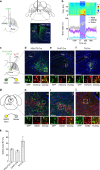Regulation of REM and Non-REM Sleep by Periaqueductal GABAergic Neurons
- PMID: 29367602
- PMCID: PMC5783937
- DOI: 10.1038/s41467-017-02765-w
Regulation of REM and Non-REM Sleep by Periaqueductal GABAergic Neurons
Abstract
Mammalian sleep consists of distinct rapid eye movement (REM) and non-REM (NREM) states. The midbrain region ventrolateral periaqueductal gray (vlPAG) is known to be important for gating REM sleep, but the underlying neuronal mechanism is not well understood. Here, we show that activating vlPAG GABAergic neurons in mice suppresses the initiation and maintenance of REM sleep while consolidating NREM sleep, partly through their projection to the dorsolateral pons. Cell-type-specific recording and calcium imaging reveal that most vlPAG GABAergic neurons are strongly suppressed at REM sleep onset and activated at its termination. In addition to the rapid changes at brain state transitions, their activity decreases gradually between REM sleep and is reset by each REM episode in a duration-dependent manner, mirroring the accumulation and dissipation of REM sleep pressure. Thus, vlPAG GABAergic neurons powerfully gate REM sleep, and their firing rate modulation may contribute to the ultradian rhythm of REM/NREM alternation.
Conflict of interest statement
The authors declare no competing financial interests.
Figures






Similar articles
-
Control of Non-REM Sleep by Midbrain Neurotensinergic Neurons.Neuron. 2019 Nov 20;104(4):795-809.e6. doi: 10.1016/j.neuron.2019.08.026. Epub 2019 Sep 30. Neuron. 2019. PMID: 31582313
-
Altered sleep architecture, rapid eye movement sleep, and neural oscillation in a mouse model of human chromosome 16p11.2 microdeletion.Sleep. 2019 Mar 1;42(3):zsy253. doi: 10.1093/sleep/zsy253. Sleep. 2019. PMID: 30541142 Free PMC article.
-
Control of REM sleep by ventral medulla GABAergic neurons.Nature. 2015 Oct 15;526(7573):435-8. doi: 10.1038/nature14979. Epub 2015 Oct 7. Nature. 2015. PMID: 26444238 Free PMC article.
-
Not a single but multiple populations of GABAergic neurons control sleep.Sleep Med Rev. 2017 Apr;32:85-94. doi: 10.1016/j.smrv.2016.03.002. Epub 2016 Mar 12. Sleep Med Rev. 2017. PMID: 27083772 Review.
-
[Neurochemical mechanisms of sleep regulation].Glas Srp Akad Nauka Med. 2009;(50):97-109. Glas Srp Akad Nauka Med. 2009. PMID: 20666118 Review. Serbian.
Cited by
-
Sleep Disorders in Children With Autism Spectrum Disorder: Insights From Animal Models, Especially Non-human Primate Model.Front Behav Neurosci. 2021 May 20;15:673372. doi: 10.3389/fnbeh.2021.673372. eCollection 2021. Front Behav Neurosci. 2021. PMID: 34093147 Free PMC article. Review.
-
Restoration of locus coeruleus noradrenergic transmission during sleep.bioRxiv [Preprint]. 2024 Jul 5:2024.07.03.601820. doi: 10.1101/2024.07.03.601820. bioRxiv. 2024. PMID: 39005471 Free PMC article. Preprint.
-
Peeking into the sleeping brain: Using in vivo imaging in rodents to understand the relationship between sleep and cognition.J Neurosci Methods. 2019 Mar 15;316:71-82. doi: 10.1016/j.jneumeth.2018.09.011. Epub 2018 Sep 9. J Neurosci Methods. 2019. PMID: 30208306 Free PMC article. Review.
-
The proteome, not the transcriptome, predicts that oocyte superovulation affects embryonic phenotypes in mice.Sci Rep. 2021 Dec 9;11(1):23731. doi: 10.1038/s41598-021-03054-9. Sci Rep. 2021. PMID: 34887460 Free PMC article.
-
Functional connectome of arousal and motor brainstem nuclei in living humans by 7 Tesla resting-state fMRI.Neuroimage. 2022 Apr 1;249:118865. doi: 10.1016/j.neuroimage.2021.118865. Epub 2022 Jan 12. Neuroimage. 2022. PMID: 35031472 Free PMC article.
References
-
- Zepelin, H., Siegel, J. M. & Tobler, I. in Principles and Practice of Sleep Medicine (eds Kryger, M. H., Roth, T. & Dement, W. C.) Ch. 8 (Elsevier Saunders, Philadelphia, USA, 2005).
Publication types
MeSH terms
Substances
LinkOut - more resources
Full Text Sources
Other Literature Sources
Molecular Biology Databases

